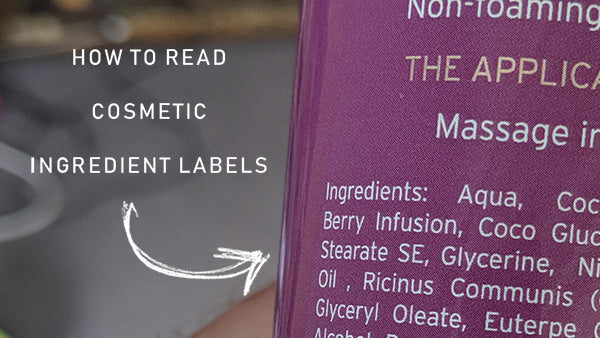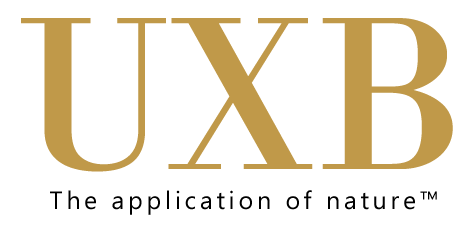
The Laws of Skincare Ingredient Labels (at least in the EU)
These are like the 6 commandments:
- The ingredients are listed in order of concentration (however, see point 4)
- The ingredients are written in their International Nomenclature Cosmetic Ingredient (INCI) names - usually latin sounding. It goes without saying that all ingredients must be listed (however, see point 3).
- You don’t have to include all essential oils or fragrance ingredients on the label - you can include them in something called Parfum.
- Ingredients included in the formulation at under 1% concentration can be listed in any order.
- Certain known allergens that may be present in essential oils and fragrances (under parfum) must be listed.
- Any colours must be listed.
Let’s take these points one by one.
Ingredients ordered by concentration
All the ingredients listed on a cosmetics label must add up to 100%. Nothing can be left off. This is interesting if the product promises to have an ingredients in a particular percentage. For example in a product with 5% glycolic acid, when you read the label, you and see glycolic acid, you will know that everything above it occurs in the formula at least at 5% or above. Everything below is below 5% concentration. Some ingredients can have an effect at low concentrations, but most don’t.
If the product doesn’t tell you how much of an active ingredient it contains you can still have a good guess by looking at where is appears on the label. If it’s not in the first 5-10 ingredients, it’s probably not going to be included in a large concentration.
The first 5 items on the ingredient list will give you a hint as to the quality of the skin care. If it contains fillers like propylene glycol or mineral oil it should hopefully be a cheap product (it’s okay to buy cheap products with fillers). If you’re seeing this on an expensive product, walk away.
Sometimes you see some ingredients you don’t recognise at the top of the ingredient list. If the headline ingredient you bought this product for (say, rosehip seed oil) is sitting directly below one of these ingredients, you can still get a clue as to the percentage of the formula that is made up by the fact that the headline ingredient is sitting next to another strange sounding chemical. Just Google “mystery ingredient name” + usage level. See, the manufacturers of these sciency sounding ingredients usually publish how much of it you should put in your formula. So, if I google “glyceryl stearate se usage level”. The website Naturally Thinking appears and suggests using it at up to 6%. We can hazard a guess that anything below this ingredient is included below at least 6%.
These aren’t hard and fast rules, but they give you a rough idea of what is in your skincare in what concentrations.
INCI names - what are they?
INCI stands for International Nomenclature of Cosmetic Ingredients. We have it so that we are all talking about the same ingredient. Your shea butter, or INCI: Butyrospermum Parkii, is the same as my shea butter in any European language.
If there is anything on the back of an ingredient label that you don’t know, my goto resources are Google and the EU’s cosmetic ingredients (CosIng) database. The CosIng database search is great because the results give you a no-frills, no marketing bullshit view of what the ingredients have been scientifically proven to do. For example, while black cumin seed oil is purported to cure everything but death, on CosIng is listed as being an emollient, skin conditioning and perfuming.
Parfum/Fragrance - what is it?
Ingredients used to fragrance the product can be “hidden” here. I was once told this is to stop people creating a direct dupe of the product fragrance. Whatever the reason the perfume/parfum/fragrance section can include many ingredients. However, these ingredients aren’t safe from scrutiny. Check out the allergens section below to find out what kind of fragrances might be used under that parfum umbrella.
The placement of Parfum/Fragrance tells us a lot. Depending on the type of product you’re formulating it is only safe to use fragrance (including essential oils) up to a certain percentage. For wash off products like shower creams it’s 2% parfum/essential oils, for leave on products like lotions, creams etc. its 1%. There are usually numerous essential oils in a product and the accumulation of all of them can’t exceed the recommended amount for wash off/leave on.
So, if you see a shower cream with parfum listed high up the ingredient list, you can bet your bottom dollar that anything below it is in there at very low concentrations.
For leave on products parfum and essential oils fall into the 1% concentration rule below.
The 1% rule - what does that tell us?
The 1% section of the ingredients label is a bit like the wild west. It’s where companies can stick ingredients in any order and then shout about them as if their product was formulated with “110% CBD” (or whatever the current en-vogue ingredient is).
You’re allowed to put ingredients in any order in this section, I think mainly because they won’t have too much effect. You will know you are in the 1% zone when you start seeing ingredients such as preservatives, essential oils and certain thickeners.
Some ingredients to look out for as a signpost that you’re in the 1% zone are:
Xanthan gum: a thickener usually used at about 0.5%
Essential oils: Here’s a good list of essential oil INCI names: https://www.oils4life.co.uk/Information-Zone/INCI-Names
Preservatives: such as Dehydroacetic acid, Benzyl, Phenoxyethanol, Ethylhexylglycerin, Sodium benzoate, Potassium sorbate
Vitamin E: usually listed as Tocopherol or Tocopheryl acetate
Any ingredient you see in and around these 1% or less ingredients is probably present in only small quantities.
What allergens must be listed?
Usually at the bottom of the ingredients list are some strange sounding things like Linalool or Citronellol. You are now in the part of the ingredients list where allergens must be listed. These compounds are found in some essential oils and fragrances and can cause irritation for sensitive skin. Quite often these ingredients has and asterisk next to them say *from natural sources. A list of the 26 allergens that must be included on labels can be found here: https://www.ecomundo.eu/en/blog/cosmetics-allergens-europe-compliance
How are colours listed in cosmetic labels?
The final think you will see on a label are colour codes. These are index numbers that look like this; CI 12085 (which is red). A list of all the colours allowed in cosmetics can be found here: http://ec.europa.eu/growth/tools-databases/cosing/pdf/COSING_Annex%20IV_v2.pdf
Conclusion
If you know how to read a cosmetic label you can have a guess at the percentage of active ingredients and hence the efficacy of the product on your skin. You can spot the reasonably priced to the nice bottle, no substance. If you pay attention to what you're putting on your skin, you'll eventually get to know which ingredients do and do not work for your skin and, the more labels you read ingredient labels, they better you will get at it.
